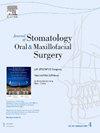Long-term enophthalmos after complex orbital bone loss successfully treated with patient-specific porous titanium implants: A case series
IF 1.8
3区 医学
Q2 DENTISTRY, ORAL SURGERY & MEDICINE
Journal of Stomatology Oral and Maxillofacial Surgery
Pub Date : 2025-02-01
DOI:10.1016/j.jormas.2024.102019
引用次数: 0
Abstract
Introduction
Long-term enophthalmos and diplopia resulting from orbital bone loss pose significant challenges in reconstructive surgery. This study evaluated the effectiveness of patient-specific porous titanium implants (PSIs) for addressing these conditions.
Materials and methods
This retrospective study involved 12 patients treated at Croix-Rousse Hospital, Lyon, from April 2015 to April 2022 who underwent late reconstruction via PSI for unilateral complex orbital bone loss. These implants were customized via 3D mirroring techniques on the basis of high-resolution computed tomography (CT) scans of the patients' unaffected orbits.
Results
All 12 patients presented with significant preoperative enophthalmos, with an average displacement of 3.24 mm, which was effectively corrected postoperatively to an average of 0.17 mm (p < 0.001). Orbital volume notably improved from a preoperative average of 3.38 mL to 0.37 mL postsurgery (p < 0.001). Functional improvements were evident as both enophthalmos and diplopia resolved completely. The Lancaster test revealed an improvement in the visual field, with 83.3 % of patients achieving normal results postoperatively.
Discussion
By ensuring anatomical accuracy, patient-specific porous titanium implants, tailored from patient-specific imaging and fabricated via advanced 3D printing technology, provide a precise, effective, and reliable solution for reconstructing complex orbital defects and performing complicated revision surgeries.
使用患者专用多孔钛植入体成功治疗复杂眼眶骨缺失后的长期眼球后凸:病例系列。
导言:眶骨缺失导致的长期眼球突出和复视给整形手术带来了巨大挑战。本研究评估了患者特异性多孔钛植入体(PSI)在解决这些问题方面的有效性:这项回顾性研究涉及2015年4月至2022年4月在里昂Croix-Rousse医院接受治疗的12名患者,他们因单侧复杂眼眶骨缺失而通过PSI进行了后期重建。这些植入物是根据患者未受影响眼眶的高分辨率计算机断层扫描(CT)结果,通过三维镜像技术定制的:所有12名患者术前均有明显的眼球后凸,平均移位3.24毫米,术后有效矫正为平均0.17毫米(p < 0.001)。眼眶容积从术前的平均 3.38 mL 显著改善到术后的 0.37 mL(p < 0.001)。眼球震颤和复视完全消失,功能得到明显改善。兰卡斯特测试显示视野有所改善,83.3%的患者术后视野正常:通过确保解剖学上的准确性,根据患者的具体成像量身定制并通过先进的三维打印技术制造的患者特异性多孔钛植入物,为重建复杂的眼眶缺损和进行复杂的翻修手术提供了精确、有效和可靠的解决方案。
本文章由计算机程序翻译,如有差异,请以英文原文为准。
求助全文
约1分钟内获得全文
求助全文
来源期刊

Journal of Stomatology Oral and Maxillofacial Surgery
Surgery, Dentistry, Oral Surgery and Medicine, Otorhinolaryngology and Facial Plastic Surgery
CiteScore
2.30
自引率
9.10%
发文量
0
审稿时长
23 days
 求助内容:
求助内容: 应助结果提醒方式:
应助结果提醒方式:


